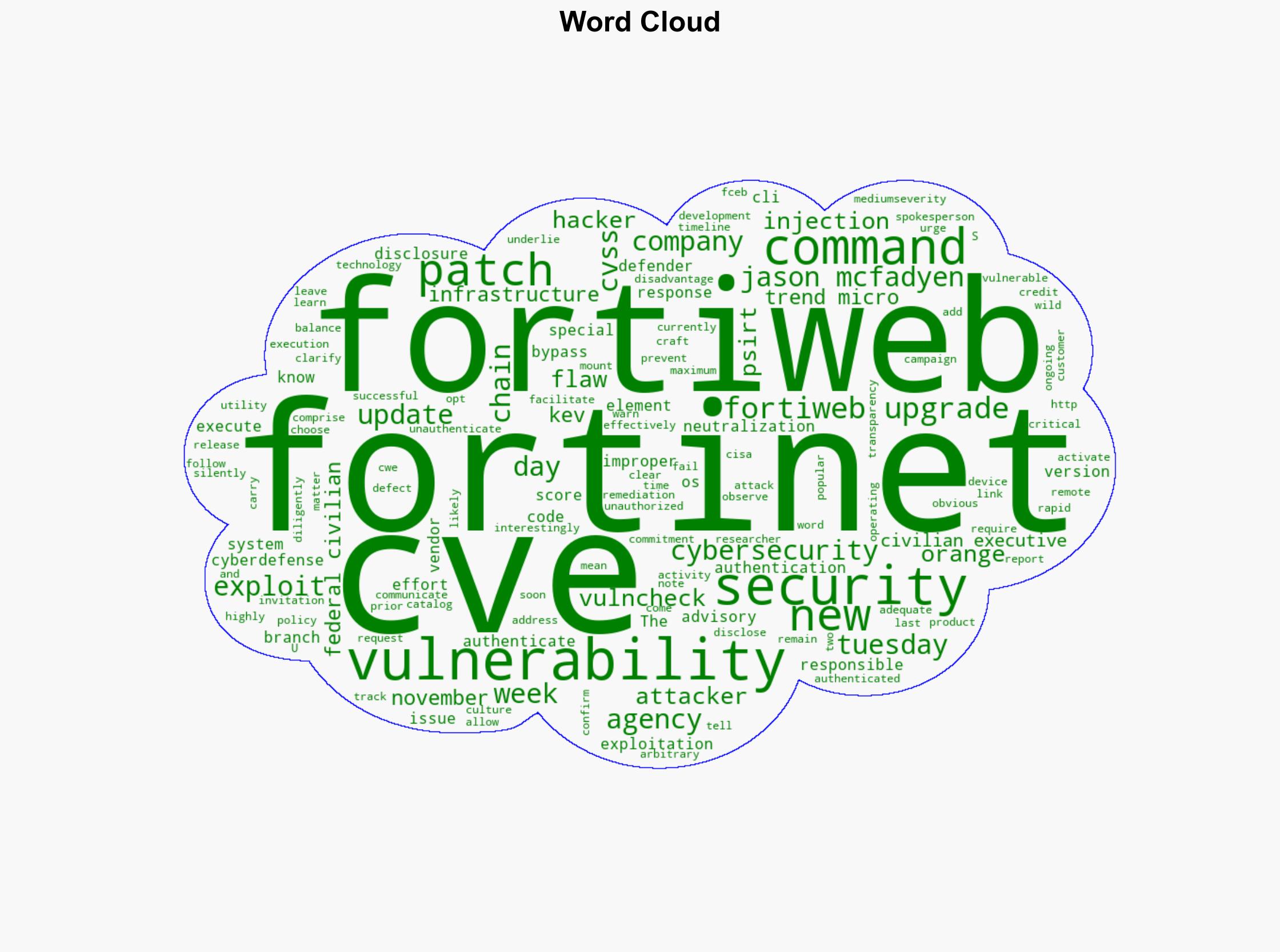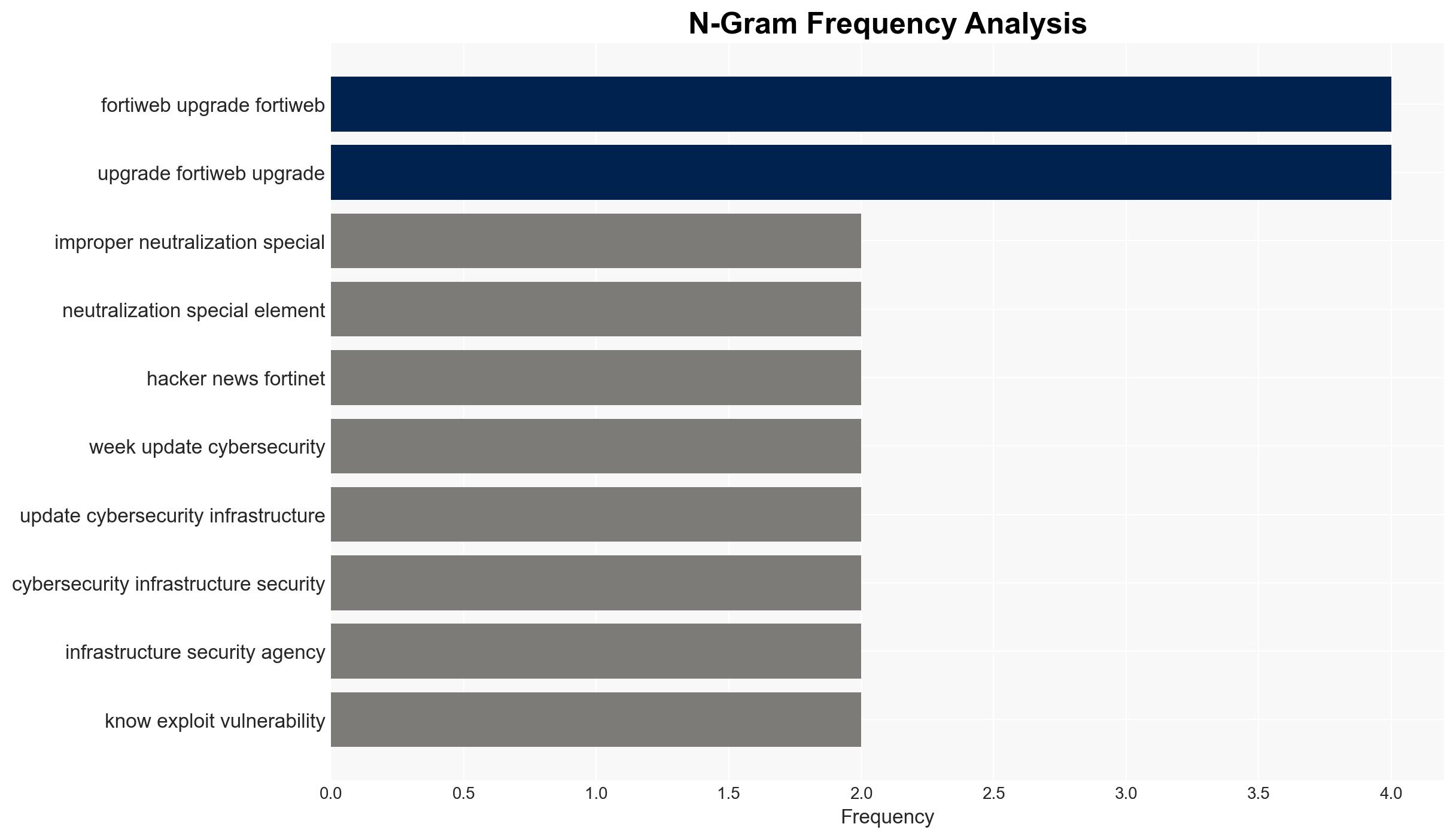Fortinet Warns of New FortiWeb CVE-2025-58034 Vulnerability Exploited in the Wild – Internet
Published on: 2025-11-19
AI-powered OSINT brief from verified open sources. Automated NLP signal extraction with human verification. See our Methodology and Why WorldWideWatchers.
Intelligence Report: Fortinet FortiWeb CVE-2025-58034 Vulnerability Exploitation
1. BLUF (Bottom Line Up Front)
The most supported hypothesis is that the Fortinet FortiWeb CVE-2025-58034 vulnerability is part of a broader, coordinated cyber exploitation campaign targeting critical infrastructure. This hypothesis is supported by the rapid exploitation observed and the linkage to other vulnerabilities. Confidence level: Moderate. Recommended action: Immediate patching of affected systems and enhanced monitoring for signs of exploitation.
2. Competing Hypotheses
Hypothesis 1: The CVE-2025-58034 vulnerability is being exploited as part of a targeted campaign by a sophisticated threat actor, possibly state-sponsored, aiming to compromise critical infrastructure systems.
Hypothesis 2: The exploitation of CVE-2025-58034 is opportunistic, carried out by cybercriminals leveraging publicly available information and tools to target vulnerable systems indiscriminately.
Hypothesis 1 is more likely due to the rapid exploitation following the vulnerability’s disclosure and its connection to other high-severity vulnerabilities, suggesting a coordinated effort rather than random opportunistic attacks.
3. Key Assumptions and Red Flags
Assumptions: It is assumed that the exploitation requires some level of sophistication due to the need for authentication bypass and command injection. The vulnerability’s exploitation is assumed to be part of a larger chain of attacks.
Red Flags: The silent patching of the vulnerability by Fortinet without an immediate advisory raises concerns about transparency and the potential for undisclosed exploitation.
Deception Indicators: The lack of immediate public disclosure may indicate an attempt to manage the narrative and control the flow of information about the vulnerability’s impact.
4. Implications and Strategic Risks
The exploitation of this vulnerability poses significant risks to organizations using Fortinet FortiWeb, particularly those in critical infrastructure sectors. The potential for unauthorized code execution could lead to data breaches, service disruptions, and loss of sensitive information. If state-sponsored actors are involved, this could escalate into broader geopolitical tensions, particularly if critical national infrastructure is affected.
5. Recommendations and Outlook
- Actionable Steps: Urgently apply patches to affected FortiWeb systems. Implement enhanced network monitoring and intrusion detection systems to identify potential exploitation attempts.
- Best Case Scenario: Rapid patch deployment and increased vigilance prevent widespread exploitation, minimizing impact.
- Worst Case Scenario: Delayed patching leads to significant breaches in critical infrastructure, resulting in economic and political fallout.
- Most Likely Scenario: Organizations patch systems in a timely manner, but some exploitation occurs due to delayed responses, resulting in moderate impact.
6. Key Individuals and Entities
Jason McFadyen (Trend Micro researcher), Fortinet, U.S. Cybersecurity and Infrastructure Security Agency (CISA), Orange Cyberdefense.
7. Thematic Tags
Structured Analytic Techniques Applied
- Adversarial Threat Simulation: Model and simulate actions of cyber adversaries to anticipate vulnerabilities and improve resilience.
- Indicators Development: Detect and monitor behavioral or technical anomalies across systems for early threat detection.
- Bayesian Scenario Modeling: Quantify uncertainty and predict cyberattack pathways using probabilistic inference.
Explore more:
Cybersecurity Briefs ·
Daily Summary ·
Support us





